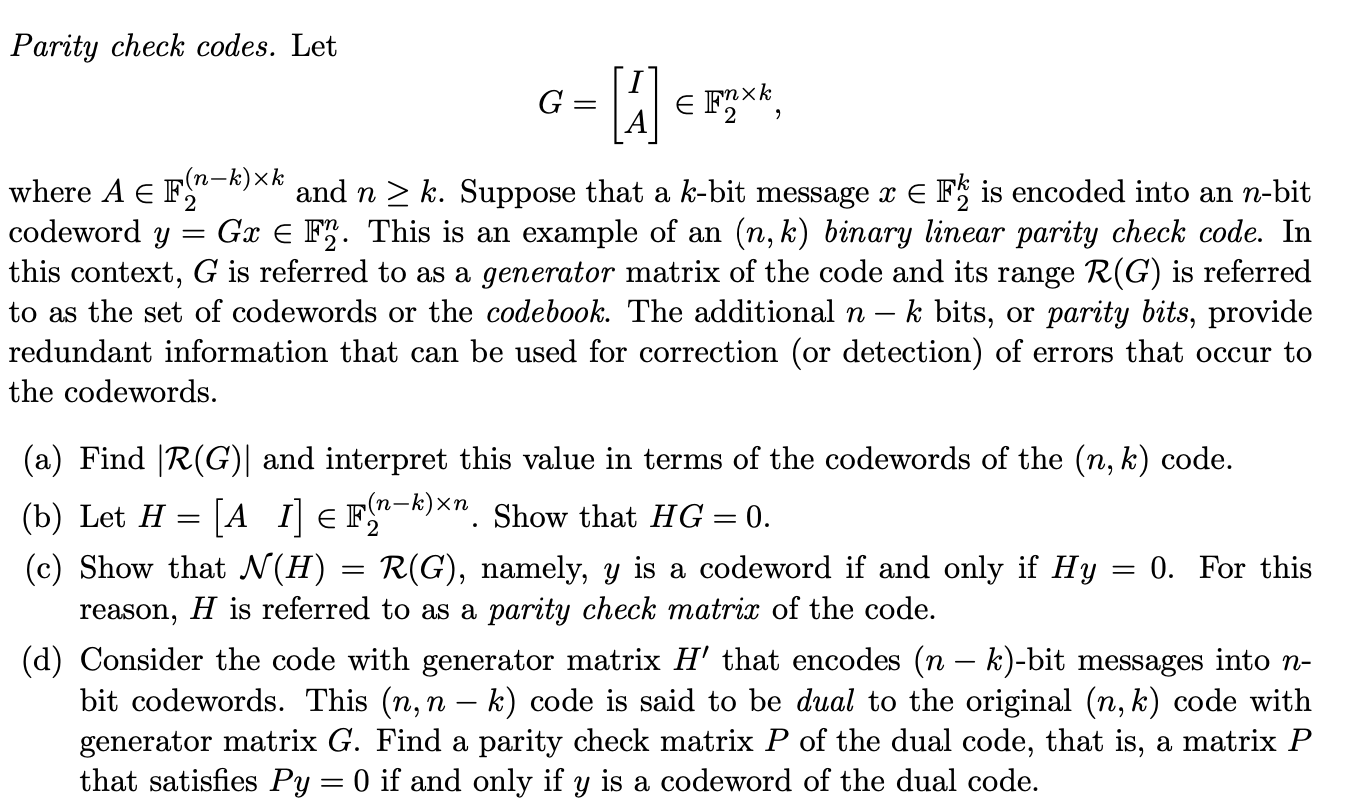(Solved) : Parity Check Codes Let N K G F2 F N K K N K Suppose K Bit Message X Fk Encoded N Bit 22 N Q43948743 . . .
Parity check codes. Let
I n×k G=A∈F2 ,
where A ∈ F(n−k)×k and n ≥ k. Suppose that a k-bit message x ∈Fk is encoded into an n-bit 22
n
codeword y = Gx ∈ F2 . This is an example of an (n, k) binarylinear parity check code. In this context, G is referred to as agenerator matrix of the code and its range R(G) is referred to asthe set of codewords or the codebook. The additional n − k bits, orparity bits, provide redundant information that can be used forcorrection (or detection) of errors that occur to thecodewords.
(a) Find |R(G)| and interpret this value in terms of thecodewords of the (n, k) code. (n−k)×n
-
(b) Let H = A I ∈ F2 . Show that HG = 0.
-
(c) Show that N(H) = R(G), namely, y is a codeword if and onlyif Hy = 0. For this
reason, H is referred to as a parity check matrix of thecode.
(d) Consider the code with generator matrix H′ that encodes (n −k)-bit messages into n- bit codewords. This (n, n − k) code is saidto be dual to the original (n, k) code with generator matrix G.Find a parity check matrix P of the dual code, that is, a matrix Pthat satisfies P y = 0 if and only if y is a codeword of the dualcode.

Parity check codes. Let G= 11 € Fyxk Fnxk 2 where A € F2=k){k and n > k. Suppose that a k-bit message x E F is encoded into an n-bit codeword y = Gx E F. This is an example of an (n, k) binary linear parity check code. In this context, G is referred to as a generator matrix of the code and its range R(G) is referred to as the set of codewords or the codebook. The additional n – k bits, or parity bits, provide redundant information that can be used for correction (or detection) of errors that occur to the codewords. (a) Find |R(G) and interpret this value in terms of the codewords of the (n, k) code. (b) Let H = [A I EFn-k)xn. Show that HG = 0. (c) Show that N(H) = R(G), namely, y is a codeword if and only if Hy = 0. For this reason, H is referred to as a parity check matrix of the code. (d) Consider the code with generator matrix H’ that encodes (n – k)-bit messages into n- bit codewords. This (n, n – k) code is said to be dual to the original (n, k) code with generator matrix G. Find a parity check matrix P of the dual code, that is, a matrix P that satisfies Py = 0 if and only if y is a codeword of the dual code. Show transcribed image text Parity check codes. Let G= 11 € Fyxk Fnxk 2 where A € F2=k){k and n > k. Suppose that a k-bit message x E F is encoded into an n-bit codeword y = Gx E F. This is an example of an (n, k) binary linear parity check code. In this context, G is referred to as a generator matrix of the code and its range R(G) is referred to as the set of codewords or the codebook. The additional n – k bits, or parity bits, provide redundant information that can be used for correction (or detection) of errors that occur to the codewords. (a) Find |R(G) and interpret this value in terms of the codewords of the (n, k) code. (b) Let H = [A I EFn-k)xn. Show that HG = 0. (c) Show that N(H) = R(G), namely, y is a codeword if and only if Hy = 0. For this reason, H is referred to as a parity check matrix of the code. (d) Consider the code with generator matrix H’ that encodes (n – k)-bit messages into n- bit codewords. This (n, n – k) code is said to be dual to the original (n, k) code with generator matrix G. Find a parity check matrix P of the dual code, that is, a matrix P that satisfies Py = 0 if and only if y is a codeword of the dual code.
Expert Answer
Answer to Parity check codes. Let I n×k G=A∈F2 , where A ∈ F(n−k)×k and n ≥ k. Suppose that a k-bit message x �…
OR